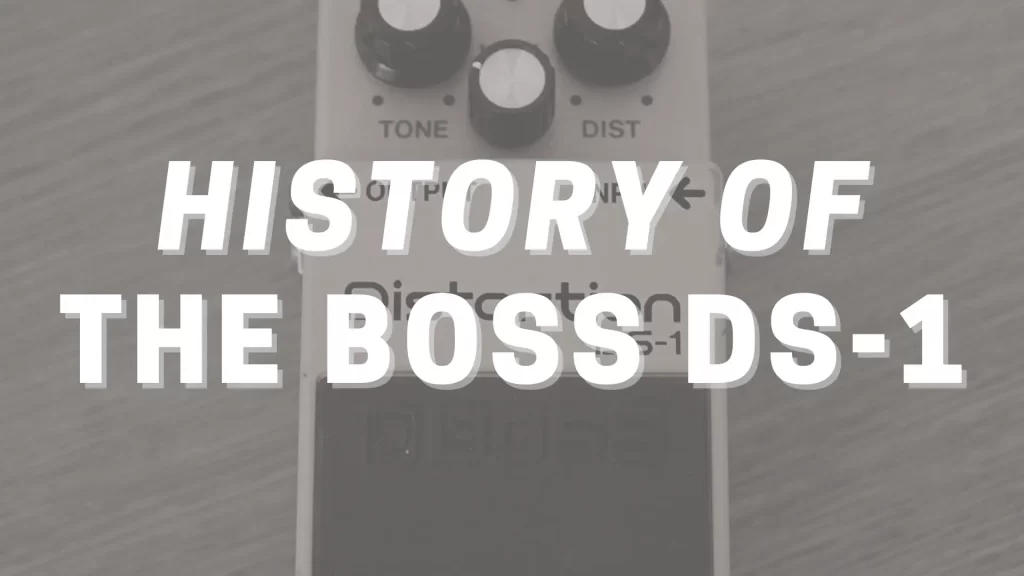
Born in 1978, the BOSS DS-1 is by far the most well-known BOSS pedal. Used by the likes of Kurt Cobain, Steve Vai, Mike Stern, and Joe Satriani, it serves as BOSS’s longest running active stompbox.
With over 40 years on the market many changes to the circuit have taken place: from slight component changes to total schematic redesign. In this article, we go over each version and their intricacies. Enjoy this history of the BOSS DS-1!
As a member of the Reverb Partner Program and as an Amazon Associate, StompboxElectronics earns from, and is supported by, qualifying purchases.
Disclaimer: Stompbox Electronics and/or the author of this article is/are not responsible for any mishaps that occur as a result of applying this content.
1978 – Made in Japan (MIJ)
BOSS designed the DS-1 in the late 70s and released it for production in Japan in 1978. It came with a noticeable metal screw, and today is seen as the most sought-after version of the DS-1. These early versions used the ACA power adapter.
Identifying an MIJ DS-1
1. Check the Back Label
To find out when your DS-1 was produced just look at the back label. If it says “Made in Japan” then you’re in luck! You might find variations (like colors and text) on the back labels from one DS-1 to another, depending on when it was produced.
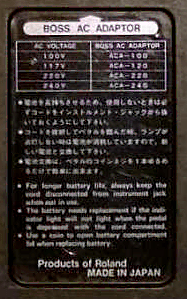
2. Check the Serial Number
In the event that the back label has peeled off, there is a second way to tell whether your DS-1 is an MIJ-era version.
On these older models, a sticker can be found underneath the lid in the battery compartment indicating the serial number of the pedal. Type that serial number into the online serial number checker to obtain a ballpark estimate on the manufacturing date of your DS-1.
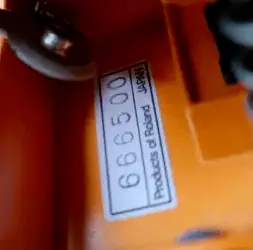
3. Check the IC
The third way to check if your DS-1 is MIJ involves a peek at the integrated circuit (IC) chip.
The MIJ version of the DS-1 has a very particular preamp IC, the TA7136AP. Open up the backplate of the pedal with a phillips head screwdriver and carefully remove the circuit board. There should be an IC labeled with either TA7136P (1978), TA7136P1 (1979), or TA7136AP (1980 and later).

The TA7136 Preamplifier IC
The TA7136 had a typical input noise voltage of 0.8uVrms, allowing Toshiba to market it as a low-noise chip. It also had a wide voltage range, from 3 to 20V, making this DS-1 version ripe for the 18Vdc mod. Of course, you’d also need to upgrade the caps to 25V ratings.
Here is the TA7136 datasheet for your convenience:
1990 – Made in Taiwan (MIT)
Around 1988 BOSS made the decision to cut prices in the face of fierce market competition from the likes of DOD and Peavey.
Between 1989 and 1990, in order to cut costs, BOSS decided to relocate production of a handful of pedals from Japan to Taiwan, taking the DS-1 with it.
Use of the TA7136AP chip continued until 1994 when the circuit encountered an almost complete overhaul.
1994 – BOSS DS-1A
A number of events occurred in the early 90s. Namely the move to Taiwan (1990), the initiation of the CE certification marking (1993), and the phasing out of the Toshiba TA7136 preamp IC.
These, coupled with the increasing number of BOSS pedals using the 9Vdc PSA supply (released in 1983), were all factors in the redesign of the BOSS DS-1 circuit. In 1994, BOSS decided to completely change its circuit design, even so far as to rename it “DS-1A” in their December 1994 service manual.
The BA728N Op Amp
With the 1994 redesign came the Rohm BA728N dual operational amplifier (op amp). Dual op amps are easily sourced and replaced, aiding in the decision to get rid of the preamp IC. The DS-1A circuit topology cascades the two internal op amps in non-inverting configuration, whereas the original DS-1 circuit employs just one preamp IC.
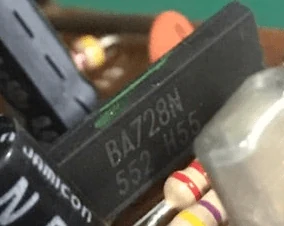
The DS-1A circuit utilizes this op amp in a single-supply fashion, so the voltage ranges from 3 to 18V. Remember, the TA7136AP had a maximum voltage rating of 20V. A modification to the DS-1A circuit for 18V might involve running the BA728N at the upper limit of its’ voltage range. Your mileage may vary with the “18V mod” on this version! You may be better off replacing the BA728N with an OPA2134 dual op-amp, which has a max voltage rating up to 36V.
Unfortunately, the noise characteristics of the BA728N op amp do not appear in the datasheet.
2000 – Y2K Changes
In the early part of the new milennium the DS-1 circuit didn’t see any large changes between subsequent versions. The op amp was the only part that changed in most cases. For example, in 2000 BOSS opted to use the Mitsubushi M5223AL instead of the BA728N.
It’s known that this model is the loudest among the DS-1 versions. It’s also known to be the “worst” version, described as “fizzy” and “noisy” when pushing the Drive/Level controls. Accounts of a volume boost when turning the tone knob have also been expressed.
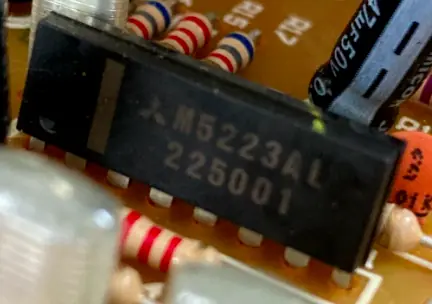
Some accounts indicate a few parts were added to the 2000 revision. In particular: R39, R40 and D8. This is yet to be confirmed.
The M5223AL Op Amp
The Mitsubishi M5223AL op amp is a dual op amp, with the same pinout as the BA728N. The closest datasheet I could find for this chip was for the M5223L, which states limited information on the noise characteristics of the op amp. That said, you can find a short blurb at the end about total harmonic distortion (THD).
Replacing the M5223AL
The 2000-2006 era can be seen as the most contentious in the history of the BOSS DS-1. Usage of the M5223AL gained such infamy that a swarm of DS-1 modifications spawned in this period. The most audacious was the direct replacement of the op amp altogether. The 4558 dual op amp became the most popular, and most controversial, replacement option.
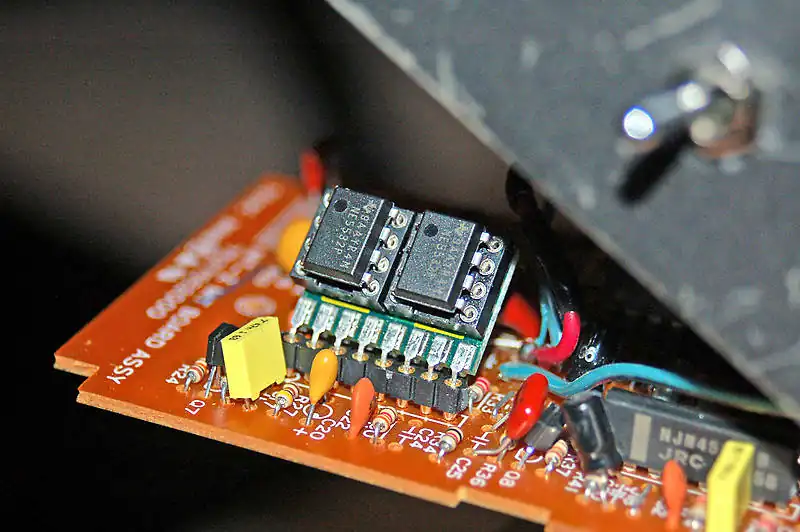
The OPA2134 op amp is another great option to use in place of the M5223AL. The mod adapter board by Monte Allums shown in the photo allows you to stack different op amps, so you can experiment with various types if you wish. Here is a list of op amps you can use to experiment:
2006 – New Japan Radio
In 2006, the M5223AL was scrapped in favor of the JRC (New Japan Radio) NJM2904 op amp. Only a connoisseur would be able to identify distinct differences in the sound compared to the previous two versions.
The NJM2904 Op Amp
This SIL chip’s voltage rating goes up to 32V, allowing once more the possibility of the 18V conversion mod. The pinout is the same as the BA728N and M5223AL, allowing possible interchange between the models.
2016 – Made in Malaysia
In another effort to cut costs BOSS started manufacturing the DS-1 in Malaysia. In 2016, it was reported that the new Made-in-Malaysia (what I’m calling MIM) DS-1 pedals made the shift from through-hole components to surface-mount technology (SMT).
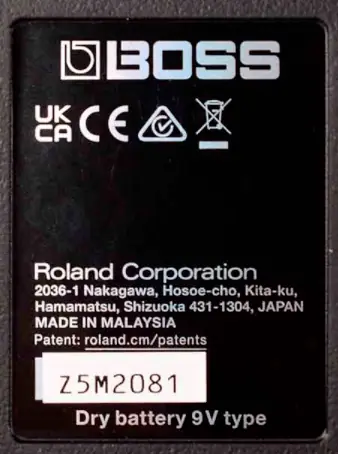
This was a major blow to the modification community, since many mods for the DS-1 relied on there being easy-to-remove through-hole components. Most modders don’t have the tools, nor the patience, to modify surface mount devices, so this is generally seen as an “un-moddable” version of the DS-1.

2017 – MIJ BOSS DS1-4A
The BOSS DS1-4A 40th anniversary version was released in 2017 sporting a sleek black enclosure. Excitement over this release in the modding community centered around the fact that it was through-hole, as opposed to the SMT version they were manufacturing at the time.
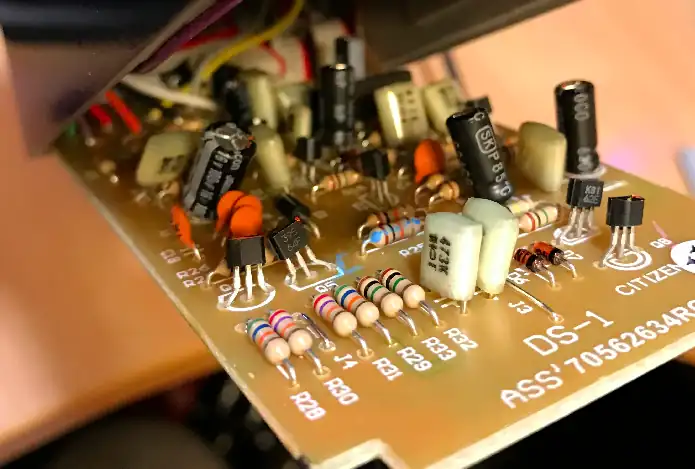
In October 2022, however, word surfaced that a black 40th anniversary pedal was found with a surface mount-style board. So for this version you need to open up the backplate and check the board before attempting to perform any modifications.
The NJM3404AL
As per the chip’s datasheet, the NJM3404AL is an enhanced version of the NJM2904 with improvements to the Slew Rate and Crossover Distortion.
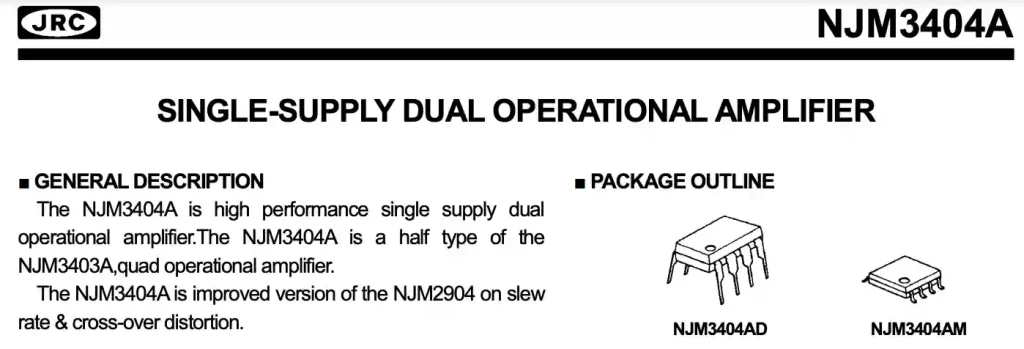
The slew rate, measured in volts per microsecond, is defined as the “the maximum rate of change of an op amps output voltage.” [1] This translates to better clarity with regard to the output signal. The higher the slew rate, the better the op amp follows the input.
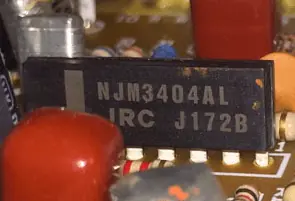
Crossover distortion is a “zero-crossing” type of distortion. That is, any reduction to the crossover distortion will result in a more integral and transparent output signal.
2022 – MIJ BOSS DS-1W
In 2022, BOSS finally released the Waza Craft version of the DS-1 – the BOSS DS-1W. This revised (and revived) DS-1 nods its’ hat to the debut version from 1978 with a signature silver screw.
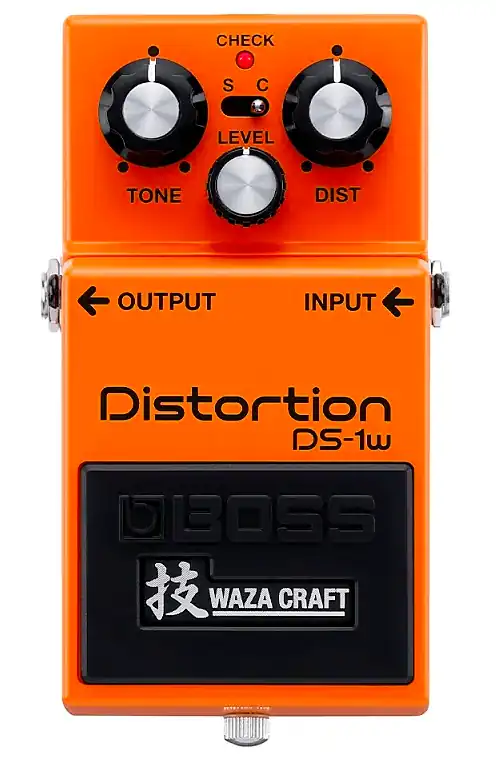
The DS-1W boasts the standard Waza treatment: a slider switch to select between S and C modes. The “S” mode (or standard mode) throws you back to the standard DS-1 sound, while the “C” mode (or custom mode), is said to be “rich, fat, and thick.”
Meet the Author:

Hi, I’m Dominic. By day, I’m an engineer. By night, I repair and modify guitar effects! Since 2017, I’ve been independently modifying and repairing guitar effects and audio equipment under Mimmotronics Effects in Western New York. After coming out with a series of guitar effects development boards, I decided the next step is to support that community through content on what I’ve learned through the years. Writing about electronics gives me great joy, particularly because I love seeing what others do with the knowledge they gain about guitar effects and audio circuits. Feel free to reach out using the contact form!
The Tools I Use
As a member of Amazon Associates, Stompbox Electronics earns and is supported by qualifying purchases.














Comments are closed.